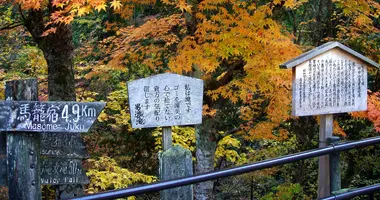Ghibli Park ジブリパーク
- Published on : 01/11/2022
- by : Japan Experience
- Youtube
Everything you need to know about the Studio Ghibli theme park
Located in the Aichi Expo Memorial Park, near the city of Nagoya, Ghibli Park is the most prominent attraction of the end of the year. After 5 years of construction, it is about to officially open its doors on November 1st. What should you expect? How can you book your ticket to Wonderland? Let's take a look.
An ode to nature
Contrary to the most famous amusement parks, such as Disneyland, Ghibli park does not rely on its rides. And for good reason: there will be none (or almost).
As in the films of the franchise, the park is intended to be an ode to nature. It has been designed to minimize its impact on the environment and be one with the 7.1 hectares of green grass that host it. “If trees were on the construction sites of certain buildings, we transplanted them." confided Goro Miyazaki, the prodigal son of the master of the walls and producer of several studio classics.
With an investment of around 34 billion yen (240 million euros), the park is destined to be a major asset for the region. We would even speak of a “symbol”, even an “ambassador” of Japanese culture, according to the governor of Aichi, Hideaki Omura, questioned on the subject during a recent press conference.
Currently, 1.8 million visitors ready to discover the bucolic world of the country's most emblematic animation studio are expected annually!
Five spaces to delight your eyes
Organized around five spaces, the park aims to be a real immersion in the world of Ghibli.
PLEASE NOTE: currently only the first three are open to the public.
"Hill of Youth"
Gateway to the world of Miyazaki, the “Hill of Youth” is located near the old north entrance of the exhibition park.
One after the other, discover life-size reproductions of the franchise's flagship works, such as Castle in the Sky (1986), Howl's Moving Castle (2004), or The Cat Returns (2002).
Among the points of interest, there will be an old pedestrian bridge converted into an observation tower which will offer a global view of the park. The latter will feature post-industrial architecture, such as can be seen in the successes of the studio.
Fans of Whisper of the Heart (1995) will also be seduced by a setting inspired by the Seiseki-Sakuragaoka district (Tokyo), where the sets of the story would be planted. Here you will find the famous orange-colored antique shop, as well as the quaint atmosphere that brought the film to life.
"Ghibli's Grand Warehouse"
It is a former public swimming pool – closed in 2018 – which served as the base for the large Ghibli warehouse. Three times larger than the Mitaka Museum, it houses an exhibition hall, a children's play area, shops, and restaurants. As well, it houses a movie theatre with approximately 170 seats, which rebroadcasts tour the 10 short films present at the Ghibli museum.
The showroom is then the heart of this space. It stages the sets of 13 major works of the franchise, including Spirited Away (2001) and the office of his witch, a reconstruction of the celestial garden of the Castle in the Sky, the catbus of My Neighbor Totoro (1988), and a room specially designed to pay homage to table scenes with plastic reproductions of the studio's most famous dishes!
You will particularly appreciate the finesse and the attention to detail, which goes as far as the reconstitution of the drops of water in Arrietty's house (Arrietty the Borrower (2010)).
“Dondoko Forest"
This fairy forest will make you walk on the footsteps of Totoro. As in the film, walk its paths and enjoy its playground. In the distance, you can see the heroines' house, as well as a 5m high wooden statue of our favorite neighbor !
"Mononoke Village"
Still closed to the public, the Mononoke village will be presented as a reconstruction of the Tataraba village, presented in Princess Mononoke (1997). Its decorations are inspired by Japanese landscapes that were then found in the Muromachi period (1336-1573), the period in which the story takes place. The opening is scheduled for fall 2023.
“Valley of Witches”
This enigmatic valley – still closed until 2023 – will include reproductions of the homes of Ghibli's most famous witches. You will also find Kiki's Bakery (Kiki's Delivery Service (1989)), where you can buy something to eat for the day. You will also find a 16m version of Howl's Moving Castle and its kitchen.
Ticket prices and reservation
To discover the wonders of the park, you will have to be patient! Reservations have been open since August 2022, so the park will be full at its opening (and probably in the days that follow).
The lottery system initially put in place, ended on October 21, 2022. The winners will be announced on Friday, November 4.
Please note: Reservations are made exclusively in advance and there will be no tickets available on-site. So, please be sure to reserve your ticket before going to the park! In addition, ticket ordering is not available outside of Japan at this moment. During the organization of your trip, ask your agency if it has contacts on-site that could allow you to obtain tickets.
Prices are variable depending on the zone. Here is a summary:
- Ghibli’s Grand Warehouse: Weekdays, 2,000 yen (€13.60) for adults and 1,000 yen (€6.80) for children. Weekends and vacations: 2,500 yen (€17) for adults and 1,250 yen (€8,50) for children. This is the only zone where the price varies during weekends and holidays!
- Hill of Youth: 1,000 yen for adults and 500 yen (€3.80) for children.
- Dondoko Forest: 1,000 yen for adults and 500 yen for children.
- The combined Ghibli’s Grand Warehouse and Hill of Youth zones: On weekdays, 3,000 yen (€20.34) for adults and 1,500 yen (€10.17) for children. On weekends and holidays, it is 3,500 yen (€23.73 ) for adults and 1,750 yen (€11.86 ) for children!
For children under 3 years old, all zones are free.
Reckless? Here are the dates not to be missed:
- Online applications for January 2023 tickets have now closed since October 21. The winners will be notified on November 4 around 3 p.m.
- Reservations for February 2023 open on November 10, 2022. Do not wait any longer!
Between Manga and Tradition
Address, timetable & access
Address
1533-1 Ibaragabasama-otsu
480-1342
Japan
Timetable
Opening: November 1, 2022
Hours: 9am-4pm. Please note that each area has its own opening hours.Price
Price: varies according to the spaces
Ghibli's Grand Warehouse : 2,000 yen (13.57 $) on weekdays for adults (child 1,000 yen =6.78 $), 2,500 yen (16,96 $) on weekends and holidays (child 1,250 yen (8.48 $))
Hill of Youth: 1,000 yen for adults (child 500 yen = 3.39 $)
Dondoko Forest: 1,000 yen for adults (child 500 yen)Access
From Nagoya Station: Meitetsu Bus Center – 4F Bus Stop No. 24 Bound for Aichi Expo Memorial ParkWebsite
https://ghibli-park.jp/en/















